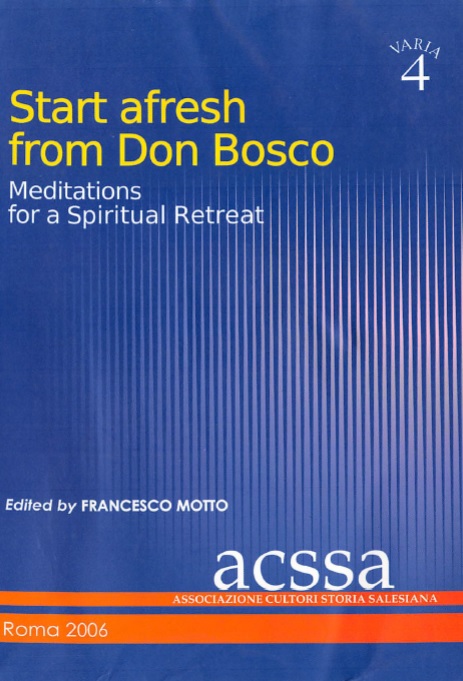And so the main object of our reflections will be the figure of Don Bosco, a figure we shall try to make contact with, not so much to understand his external actions which we all know about already, but rather to understand the conditions, the motivations, the spirit which led him to make specific choices, to work in a specific way, to write about particular matters, to reach a particular form of holiness which is specifically his own, different in some ways from that of other saints.
E così l’oggetto principale delle nostre riflessioni sarà la figura di Don Bosco, una figura con la quale cercheremo di entrare in contatto, non tanto per capire le sue azioni esterne che già tutti conosciamo, ma piuttosto per capire le condizioni, le motivazioni, lo spirito che lo ha portato a fare scelte specifiche, a lavorare in modo specifico, a scrivere su argomenti particolari, per raggiungere una forma particolare di santità che è propriamente la sua, diversa per certi versi da quella di altri santi.
CONTENTS:
- Preface
- Introduction
- The first day: Faith
- 1. Living within the history of Don Bosco, in the Church of Christ
- Introduction
- 1. A struggling Church at the dawn of the third millennium
- 2. Re-establishing the “minority” phenomenon of consecrated life
- 3. The historical forms of consecrated life
- 4. Trends of change and the manner in which it took place
- 5. Some fixed points
- Conclusion
- 2. Don Bosco: secrets of success
- Introduction
- 1. A very high esteem of every individuai called by God to salvation
- 2. Deep values expressed in social action
- 3. A clear priestly identity
- 4. The universal allure of his person
- 5. A great communicator of the youth problem
- 6. Resurgence of holiness
- Conclusion
- The second day: Hope
- 3. Those formidable first twenty years (1815-1835)
- Introduction
- 1. In his native surroundings (1815-1831)
- 2. Young student at the Chieri High School (1831-1835)
- 3. The vocational choice: summer 1835
- 4. Consequences of the choice
- Conclusion
- 4. Ten years of preparation (1835-1844)
- Introduction
- 1. In the Chieri seminary (1835-1841)
- 2. At the Turin Ecclesiastical College (1841-1844)
- 3. A new priest with a specific program
- 4. Don Bosco, priest and educator, writes to clerics
- Conclusion
- The third day: Charity in the Holy Spirit
- 5. The fundamental option: the young (1844-1846)
- 1. A fundamental document
- 2. “The problem lies in finding ways to bring them together, to be able to speak to them and teach them some moral principies”
- 3. Evolution of the Oratory: from the first festive oratory to a vast range of educational works in response to emergencies
- 4. Types of young people cared for
- 5. Kinds of youngsters extraneous to the activities of Don Bosco
- Conclusion
- 6. The vital choice: consecrated and sent for a communal mission (1854-1874)
- 1. The two dimensions of the Salesian: consecrated and sent
- 2. The two dimensions inherent in the choice of vocation
- 3. A strange omission: Don Bosco as a “Salesian”
- 4. Conditions: the vows
- 5. In community
- 6. Two instruments of choesion
- 7. Communities in development
- Conclusion
- The fourth day: Personal rapport with Christ
- 7. The strategie turning point: the missions
- 1. The missionary turning point of the congregation
- 2. Features of “missionary spirituality” in the “Souvenirs for missionaries”
- 3. Features of “missionary spirituality” in correspondence with superiors on the missions
- 4. Fragments of spirituality in letters of animation
- Conclusion
- 8. The Salesian mission at the present day
- 1. Mission: explicatio terminorum
- 2. The Salesian way of “mediation”
- 3. Phenomenology of attitude to what is “new”
- 4. Three innovations that require careful consideration
- 5. Practical guidelines
- Conclusion
- The fìfth day: Salesian Holiness
- 9. Is the policy of the Pater Noster still valid?
- 1. The “politicai credo”of Don Bosco
- 2. The present-day world
- 3. Some questions we can put to ourselves
- 4. A first step forward: educate ourselves and others to political virtues
- 5. A second step forward: educate ourselves and others to the Christian social virtues
- Conclusion
- 10. Don Bosco’s preventive system today
- 1. Premise: relevant Preventive System because put into practice
- 2. Two versione of preventative education
- 3. Greater “openings” for a preventative education
- 4. A new anthropological and theological foundation for “honest citizen and good Christian”
- 5. Pedagogical and psychological concerns
- 6. Holiness and salvation
- 7. The familiar trilogy
- 8. Educator who is father, brother, friend
- Conclusion
- The sixth day: Accompanied by the mother
- 11. Final homily
- Appendix
- An invitation to reflection about congregation’s history
- Introduction: Relevance of the theme
- 1. At the Salesian origins
- 2. The function of History
- 3. The present situation
- 4. For a renewed historiography, non contingent and of high profile
- Introduction: Relevance of the theme
- Index
Reference time period: 1815 – 2006
F. Motto (a cura di), Start afresh from Don Bosco. Meditations for a Spiritual Retreat, Roma, Associazione Cultori Storia Salesiana, 2006 (Varia, 4).
Reference institution:
Associazione Cultori Storia Salesiana (ACSSA)
